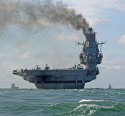The Navy is not yet delaying the anticipated deployment for carrier USS Gerald R. Ford (CVN-78) in the early 2020s after a series of delays, but workups and training could be compressed due to a later-than-expected delivery, the Navy’s chief weapons buyer said last week.
Sean Stackley — assistant secretary for research, development and acquisition — told reporters that testing for the new carrier was on track.
“We haven’t adjusted the deployment schedule, but we’re working with the existing deployment schedule and recognizing with the delay to delivery, that that’s going to compress some events and we’re going to have to evaluate that to ensure that we’re not cutting short the crew,” Stackley said.
While an official deployment date for the ship – set to deliver in in April – has not been put forth by the Navy, USNI News understands the ship should leave on its first deployment around 2021 after completing substantial testing of the ship’s systems, its ability to interoperate with other platforms in the carrier strike group, and standard pre-deployment workups.
The more-than-$12-billion Ford has suffered a string of delays largely due to the variety of complex systems that were included at the inception of the program in the 2000s, when then-Secretary of Defense Donald Rumsfeld insisted new acquisition projects should include transformational technology.
“It’s the first new designed aircraft carrier in 40 years. Significant number of new, advanced systems that don’t exist anywhere else in the world,” Stackley said.
“It’s not until you bring them all together on the aircraft carrier that you get to test the fully integrated system, and so with all first-of-class ships we have been in a bit of a test-and-fix mode as we go through the test program.”
The delivery date for the ship pushed several times last year, in part due to problems in the ship’s power grid, Stackley said.
“With specific regards to the [Ford], we ran into a fairly significant issue in the test program in the power distribution side of the house that didn’t just cause us to slow down to resolve the technical side, but then there was also a repair side as well,”
“So from last summer to the end of the year in [2016] there was a very intense effort to solve the technical, to test out the technical fixes, implement the technical fixes and get back on track with completing that portion of the test program.”
The ship is set to leave Huntington Ingalls Industries Newport News Shipbuilding in March for builders trials ahead of delivery.
The following is the complete statement from the U.S. Navy on the status of the Ford carrier.
“GERALD R. FORD (CVN 78) is 99 percent overall complete with 93 percent of the test program complete (93 percent Hull, Mechanical & Electrical, 92 percent propulsion testing, and 93 percent electronics testing). Over the past few months, we have made significant progress resolving first-of-class issues associated with these critical systems and have resumed critical path testing in support of Builder’s Sea Trials. This progress enables us to forecast our sea trials and delivery schedule. Specifically, we have updated the ship’s schedule to reflect Builder’s Sea Trials in March 2017, Acceptance Trials in April 2017, and Delivery in April 2017, pending the results of sea trials.”


